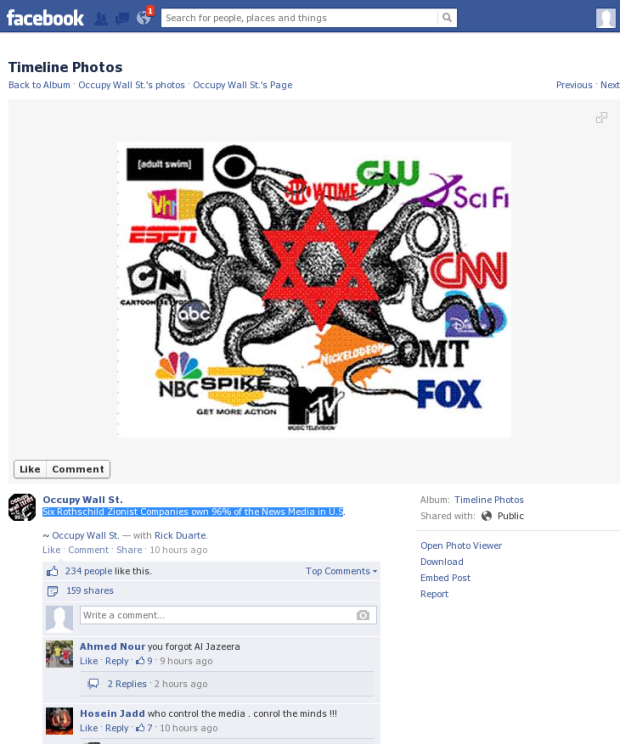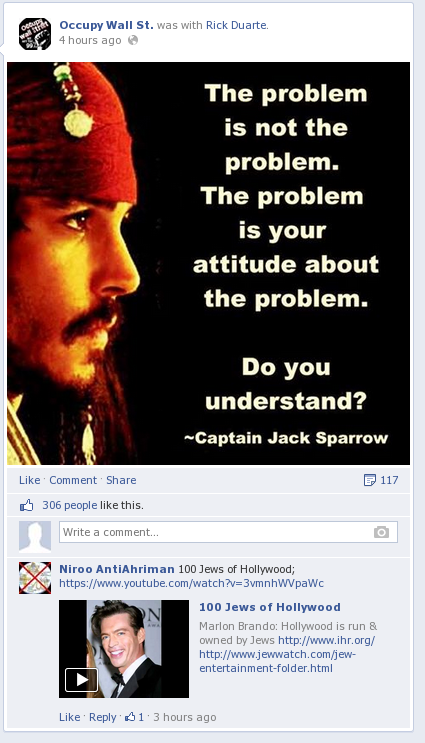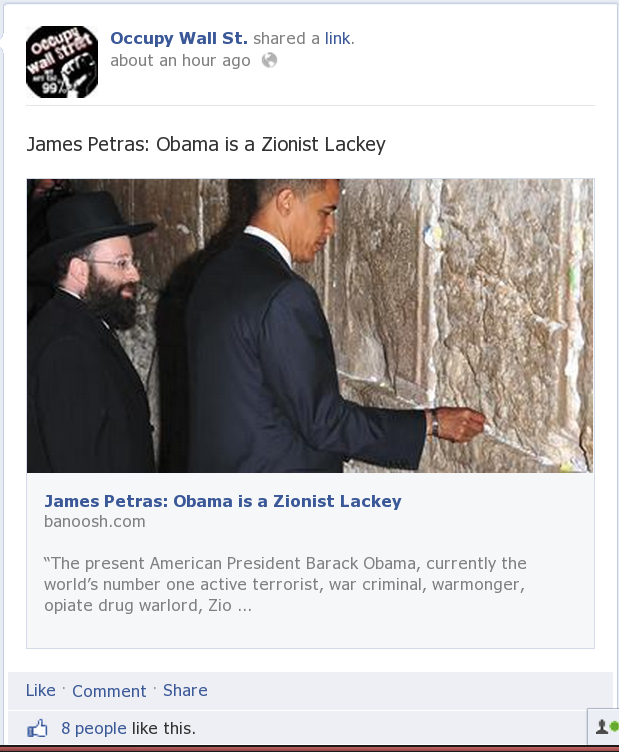http://www.e-flux.com/journal/politics- ... d-beliefs/John Miller
Politics of Hate in the USA, Part II: Right-wing Mysticism and BeliefsThe following text, which is the second of three installments, traces back to a conversation I had with Mike Kelley in 1994, “Too Young to be a Hippy, Too Old to be a Punk.”1 Christophe Tannert at Kunstlerhaus Bethanien in Berlin had invited us to discuss underground political and aesthetic culture in the US for the first issue of Bethanien’s Be Magazin. One year later, I followed this up with a narrative account and analysis of the subject, “Burying the Underground.” Meanwhile, a series of sieges, armed standoffs, and bombings made Americans increasingly aware of a growing polarization between the US federal government and what was hardening into a grassroots militia movement: Ruby Ridge (1992), Waco (1993), Oklahoma City (1995) and Fort Davis, Texas (1997). I began to see this as a right-wing counterpart to militant leftism. In fact, the right seemed to be mirroring tactics that had previously belonged to the leftist underground. This led me to write a complementary essay, “Heil Hitler! Have a Nice Day!, the Politics of Hate in the U.S.A.” By 2001, the militia movement had run out of steam. When al-Qaeda terrorists staged the September 11 attacks, however, these so closely resembled events described in William Pierce’s pseudonymous manifesto, The Turner Diaries, that I had initially suspected the radical right. Although unemployment and economic dislocation drove the militia movement, the Great Recession has not provoked a similar response. Instead of overturning—or seceding from—the federal government, the far right, now exemplified by the Tea Party, wants to work from within the political system by downsizing government and converting it to a states’ rights model. This shift is evident in the current Republican debates leading up to the next presidential election, where candidates have tried to turn “moderate” into a pejorative term.—
John Miller
→
Continued from “Politics of Hate in the USA, Part I: Repressive Tolerance”***
Conspiracy TheoryModern conspiracy theory traces its roots to the French cleric Abbé Barruel. In 1797 Barruel wrote an account of the French Revolution focused on the Jacobins. Behind the Jacobins he saw a conspiracy of three secret societies: the Order of Templars, the Order of Freemasons and the Illuminatti.2 In 1806 the retired army officer J.B. Simonini praised Barruel’s analysis in a letter to him, but pointed out “the omission” that Jews had founded both the Freemasons and the Illuminatti for world domination.3 In his book
Proofs of a Conspiracy Against All the Religions and Governments of Europe, the Scotsman John Robison further argued, “Nothing is more clear than that the design of the Illuminatti was to abolish Christianity.”4 Many in the United States, clergymen especially, greeted the French Revolution with suspicion. In May1798 the Reverend Jedidiah Morse warned of a Jacobin-derived plot against American political and religious institutions. Soon after, journalists exposed the Robison book as fraudulent. By the end of 1799 the Illuminatti affair was, for the time being, over.5
Around 1891 the novel Biarritz, written by Prussian postal worker Hermann Goedsche under the pen name Sir John Retcliffe, gained notoriety throughout Europe. What captivated many of its readers was a sensationalistic chapter entitled “In the Jewish Cemetery in Prague.” In it, elders from the twelve tribes of Israel gather at the grave of the most venerable rabbi and discuss the progress of their plot to take over the world. This text was reprinted as a pamphlet called “The Rabbi’s Speech” and distributed throughout Russia and France. In time, readers came to accept this story as fact and it became the basis for the
Protocols of the Elders of Zion. The
Protocols purport to be a transcript of lectures given by leading Jews at a 1840 world congress in Cracow, Poland.6 They were pieced together between 1872 and 1895 from various sources: the writings of Barruel, Simonini, Goedsche plus books by Maurice Joly and Gougenot des Mousseax. 7 James Ridgeway has summarized them as follows:
The Protocols argue that people are incapable of governing themselves, and only a despot using armed force can govern effectively….[The Jews have plotted their] rise to power by pitting the Gentiles against one another until, eventually…[they] will be able to enlist the masses in overthrowing their indolent gentile leaders. Thereafter the masses will be kept under firm control through an efficient government that will banish unemployment, apply taxation in proportion to wealth, and promote education. During this messianic age the Jewish masters will shrewdly promise, but never deliver, liberty.8
Although London Times correspondent Philip Graves showed parts of the Joly’s book had been plagiarized in the Protocols, they too became accepted as fact. Shortly before the October Revolution, the czar’s secret police published another version in an attempt to smear its opponents.9
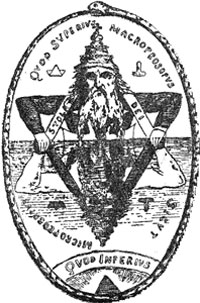 The Jew Bolshevic Emblem surrounded by the
The Jew Bolshevic Emblem surrounded by the
Symbolic Serpent in the Protocol book.In the 1920s Henry Ford widely distributed the Protocols in the United States. His weekly newspaper, the Dearborn Independent, included them as part of a series on “the Jewish international conspiracy.” According to the Independent, Jewish influence was everywhere. Jews forced William Howard Taft to break a commercial treaty with Russia (thereby weakening the czar). They controlled Woodrow Wilson’s administration, particularly through Bernard Baruch, chair of the War Industries Board. (Wilson initiated the League of Nations, forerunner to the far right’s much hated United Nations.) Communism itself was a Jewish plot. The Independent also charged that Paul Warburg intended to control the US financial system with the Federal Reserve. Ford later anthologized the entire series as The International Jew and distributed the book worldwide. Half a million copies circulated in the US alone. In Germany, it became a cornerstone of fascist propaganda. In 1927 Aaron Sapiro sued the Independent for libel in its series “Jewish Exploitation of Farmer Organizations.” Although the lawsuit ended in a mistrial, Ford closed the newspaper.10 During this highly publicized case, the Independent’s editor, William J. Cameron, took full blame for the newspaper’s policies. Wilson and the Warburg family also challenged Ford’s accusations. Ford retracted them, claiming his employees had published the material without his consent. Yet, in 1938, Ford accepted the Grand Cross of the German Eagle, becoming the first American to be decorated with that medal.11 Christian Identity expert Michael Barkun has noted the irony of Ford’s anti-Semitism:
The so-called “pseudo-agrarian” movements…beginning in the 1890s…sought to blame rural and small-town social dislocations on an urban, plutocratic conspiracy. More often than not, this cabal was identified as explicitly Jewish, and it became a convenient scapegoat for those troubled by departures from traditional social values. It was ironical that Henry Ford, himself an agent of some of these changes…became…one of the principal voices for an anti-Semitic politics of resentment.12
In the 1930s a new religious revival swept across the US, reviving, among other things, the anti-Semitism Ford had espoused earlier on. Just as a convulsive modernization left Germany open to Nazism, so economic turmoil and rapid urbanization drove many Americans to fundamentalist religion. With fire and brimstone preachers grimly warning of the coming apocalypse, paranoia and racism were overlaid on these beliefs. Three figures dominated the fundamentalist movement: Gerald B. Winrod, William Pelley and Gerald K. Smith.13
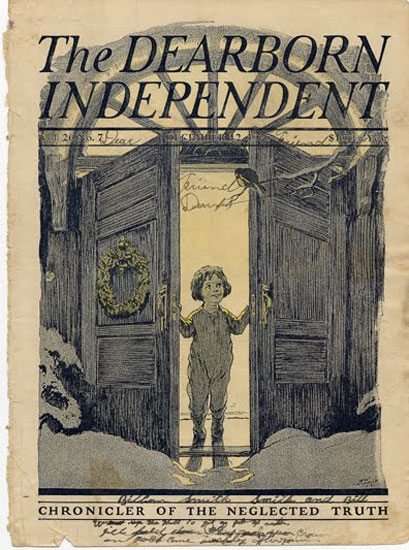 The Dearborn Independent newspaper printed by Henry Ford, 1925.
The Dearborn Independent newspaper printed by Henry Ford, 1925.Gerald B. Winrod preached that Christ would soon return for the Battle of Armageddon. He believed that while anti-Semitism is founded in Biblical prophecies, only a “certain element” of world Jewry advocates subversion. The widow of Christian Identity minister Wesley Swift believes that it was Winrod who introduced her husband to British-Israelism, the paradoxical forerunner to the Identity movement that first identified with Jews, then turned anti-Semitic.14 What distinguished Winrod from other preachers was his 1938 bid for US Senate in Kansas. He finished third in the Republican primary elections with considerable support from Mennonite communities and the Ku Klux Klan.15
At the outset of his career, William Pelley had been a supporter of Woodrow Wilson and the League of Nations. In 1927, he underwent a sudden mystical transformation, withdrawing from society and experiencing a “rebirth” during which he claimed to have heard voices from other worlds. He came back to public life believing in reincarnation—particularly in the reappearance of “demon souls” as Jews. Later, Pelley embraced the work of “pyramidologist” David Davidson, who was a follower of British Israelism. By integrating Davidson’s work with anti-Semitism, Pelley helped lay the groundwork for Christian Identity. 16 After Hitler came to power in Germany, Pelley founded the Silver Legion—or Silver Shirts as Pelley sometimes called them, after the Brown Shirts. Pelley even claimed that Christ himself had accepted his offer to become an honorary Silver Shirt. In 1942, trying to quash nativist reactionaries, the Roosevelt administration charged both Pelley and Winrod with sedition. Pelley spent fifteen years in prison.17
Like Winrod, Gerald K. Smith was a fundamentalist who entered politics. In 1933 he joined Pelley’s Silver Shirts, then went on to help manage Huey Long’s presidential campaign. After Long’s assassination in 1935, Smith unsuccessfully ran for office himself. He then formed the Union Party with Father Charles Coughlin and Francis Townsend. The Union Party ran William Lemke against Roosevelt in the 1936 election, but received less than a million votes. Smith next moved to Detroit and met Henry Ford who sponsored his radio broadcasts and furnished him with investigators for compiling the “Ford Company Red File,” a list of known or suspected communists. This work inspired feverish visions of Jewish conspiracy in Smith’s mind. He proclaimed, “Communism is Jewish” and speculated that Roosevelt never died, but that Jews had hidden him to later bring him back as “President of the World.” Even after the Second World War, Smith maintained that people had misunderstood Hitler and that the holocaust was a hoax. Despite his bizarre speculations, Smith was a commanding speaker who could rally large audiences. During the Second World War he met with Christian Identity theologian Wesley Swift and converted to the obscure sect that now provides a religious and ideological foundation for many recent hate groups.18 As an agitator, Smith helped politicize the Identity movement; using key Identity figures to forward his own political agenda, he lent coherence to an otherwise fragmented movement.19
Kenneth Goff, a Christian Identity minister and protegé of Minuteman founder Robert DePugh, claims the conspirators have continued to control international politics even today. According to him, Benito Mussolini, Nikolai Lenin and Colonel E. Mandel House (a chief aide to Wilson) laid the plans for the First World War at a conference in Belgium during the early 1900s. After House convinced Czar Nicholas II to abdicate his throne, Jacob Schiff, through the financial firm of Kuhn, Loeb & Co., engineered Lenin’s rise to power. To cover their tracks, Zionists launched a “disinformation campaign” portraying their allies, the Russian Communists, as anti-Semitic. Goff claims that the international Jewish banking cabal further consolidated its hold on the world economy through marriages between the Loeb, Rothschild and Warburg families. To win sympathy, they fabricated accounts of the holocaust in Nazi Germany and continue to use the charge “anti-Semitic” to disable their critics. The “Jewish” agent Alger Hiss, served on the US delegation to the Yalta Conference and helped arrange to grant the Soviet Union veto power in the United Nations.20 From Goff’s perspective, a secret cabal controls mainstream television, radio and newspapers as well: the so-called “Jews’ media.” Those who subscribe to anti-Semitic conspiracy theories have come to call the Federal government the Zionist Occupation Government—or ZOG, for short.
In 1991, Pat Robertson’s book The New World Order became a New York Times bestseller with almost a half million copies in print. The book has effectively legitimated the bizarre ideas of the patriot movement within a broader evangelical Christian community. Although his book simply updates well-established conspiracy themes, Robertson, then unofficially heading the Christian Coalition, disavowed that approach.21 Nonetheless, he claimed to have traced “an invisible cord” of influence connecting “[Woodrow] Wilson…to the JP Morgan bank, to the Rockefellers and the Council on Foreign Relations…to the powerful Carnegie, Rockefeller and Ford Foundations, to the United Nations, to Henry Kissinger…,to the Trilateral Commission, to Jimmy Carter, to George Bush.” Critic Michael Lind attacked Robertson’s implicit racism in the February 1995
New York Review of Books:
Not since Father Coughlin or Henry Ford has a prominent white American so boldly and unapologetically blamed the disasters of modern world history on the machinations of international high finance in general and on a few international Jews in particular.22
Robertson responded, “I deeply regret that anyone in the Jewish community believes that my description of international bankers and use of the phrase “European bankers” in my book refers to Jews.”23 Even so, Robertson quoted the work of well-known anti-Semites Nesta Weber and Eustace Mullins in support of his theories.24 Defenders of the book dismissed its anti-Semitism by pointing out Robertson’s support for Israel. For a dispensational premillennialist such as Robertson, backing Israel does not necessarily preclude anti-Semitism. According to this belief, the Jews must return to Israel before the Second Coming.
Michael Barkun has described how conspiracy theory relies on an inverse logic of credibility: one that stigmatizes ideas bearing the approval of prestigious institutions and that legitimizes, by default, those not associated with such institutions. He links this inversion to British sociologist Colin Campbell’s notion of the “cultic milieu”:
[which] refers to a society’s “rejected knowledge,” beliefs considered unacceptable by such authoritative institutions as conventional religion, universities, the state, and the mass media. Second, the cultic milieu refers not simply to this body of rejected knowledge but to its expression in the form of a “cultural underground,” a “network of individuals, groups, practices, institutions, [and] means of communication.” 25
Clearly, this inverse logic is a compensatory rationalization of otherwise unacceptable social changes. It pertains not so much to active cultural dissent itself as it does to withdrawal from status quo adversity. A disaffected person is always the most susceptible to this form of belief. One can always more easily scapegoat another than confront one’s own failings. Consensus within a cult, moreover, can intensify and seemingly objectify almost any belief. Laird Wilcox, a critic of the radical right, points out that once people enter conspiracy discourse, they become “insulated from outside forces, they listen to themselves and no one criticizes them….You have an internal myth built up by this incestuous feedback.” 26 Political analyst Chip Berlet further observes that once a group establishes this insularity, “instead of engaging in a political struggle based on debate, compromise, and informed consent, . . . [conspiracy theorists only] want to expose and neutralize the bad actors.” 27 Recently, the emergence of the Internet has reinforced this kind of thinking. There, when verification for these ideas is lacking, predisposition—i.e.,
a fervent need to believe—sanctions them anyway.
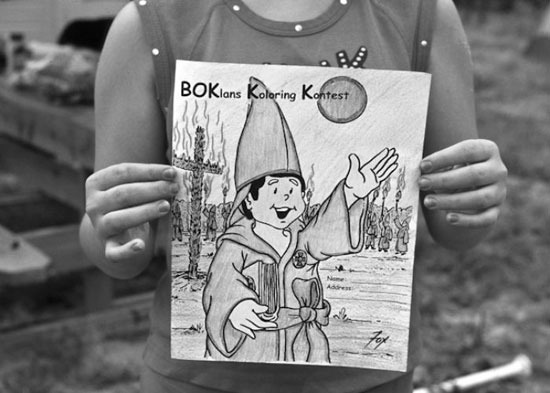 Apocalypticism
ApocalypticismApocalyptic visions sometimes drive radicalism on both the left and right. For example, Walter Benjamin’s conception of
jetztzeit (based on the Jewish messianic vision of history) posits a break with the “dead time” of bourgeois society. This idea has become central to the postmodern critique of progress. The Jewish messianic tradition similarly inspired Abbie Hoffman. Myth drives revolutions, in the end, more than rationalism. If the left’s vision is characteristically expansive and utopian, religious fundamentalism and a sense of creeping social deterioration distinguish the right’s sense of the apocalypse. That sense, moreover, is literal, not allegorical. The Book of Revelations prophesies a final Battle of Armageddon; the Catholic Douay Version of the Scripture calls this book the Apocalypse.28 “Revolutionary millenarianism” rejects the gradualism of ordinary political struggle with its demand for immediate and convulsive social change:
It is characteristic of this kind of movement that its aims and premises are boundless. A social struggle is seen not as a struggle for specific, limited objectives, but as an event of unique importance, different in kind from all other struggles in history, a cataclysm from which the world is to emerge totally transformed and redeemed.29
By the end of the Second World War the arrival of nuclear weaponry made apocalyptic biblical predictions technologically possible. Thus, if the prospect of thermonuclear annihilation did not produce enough anxiety by itself, some further saw “the Bomb” as the instrument of religious prophecies. In 1971, future President Ronald Reagan warned the California State Senate:
Ezekiel 38 and 39 says that Gog, a northern power, will invade Israel. Gog must be Russia. Most of the prophecies that had to be fulfilled before Armageddon can come have come to pass. Ezekiel said that fire and brimstone will be rained upon the enemies. That must mean that they’ll be destroyed by nuclear weapons. 30
This was the same man who joked “Start bombing in five minutes” and initiated the “Star Wars” defense system. His Secretary of the Interior, James Watt, ordered the clear-cutting of national forests thinking that, in the not-too-distant future, no one would be left to enjoy them anyway. As the Reagan Revolution pushed forward (or backward), author Hal Lindsey published a series of bestsellers interpreting global politics according to the Book of Revelations. These include The Rapture, The Terminal Generation, There’s a New World Coming, The 1980s: Countdown to Armageddon and The Late Great Planet Earth. The last title, in which Lindsey interpreted current events according to the biblical Seven Seals, sold more than 18 million copies. 31
Fear of a coming apocalypse sparked a survivalist movement across America. Christian Fundamentalists, however, are not prone to survivalism because they believe in the rapture, i.e., that Christ will appear and bring them to heaven for the Tribulation. In contrast, historic premillenialists such as Identity Christians expect to actively battle the Anti-Christ during Armageddon.32 Because urban centers would be the first to go in a missile strike, survivalism took root in the countryside. Just as air-raid sirens and fallout shelters sprouted up all across America during the 1950s, people today take matters into their own hands by stockpiling freeze-dried foods, water, clothing and weapons. Survivalism, however, is at root anti-social. It signals that one has somewhat abandoned normal social intercourse as an adequate basis for personal and public life:
[T]he act of radical withdrawal can engender a siege mentality, a sense that one is surrounded by enemies and that the battle is even now beginning. Thus survivalists are prey to the self-fulfilling prophecy, in the sense that their very preparations may lead them into actions that set them at odds with political authorities.33
Dug in and braced for the Bomb, some start to regard a nuclear holocaust as a solution instead of a problem.
Despite the very real threat of nuclear weaponry, Apocalypticism is symptomatic of forces that are, by default, excluded from its mythology. Its radical themes and iconography distract discussion from the root causes of rural crises:
To most of us, apocalyticism, at least in its thoroughgoing manifestations, is so spectacular, so potentially destructive, that is difficult to look beneath its surface….As one can see from the history of it, it nearly always arises in times of suppression, chaos, fear, or disadvantage. As such, its first appearances are a register of the degree of social and psychological pain people are suffering.34We are dealing with frightened people caught in the jaws of history, not kooks.35
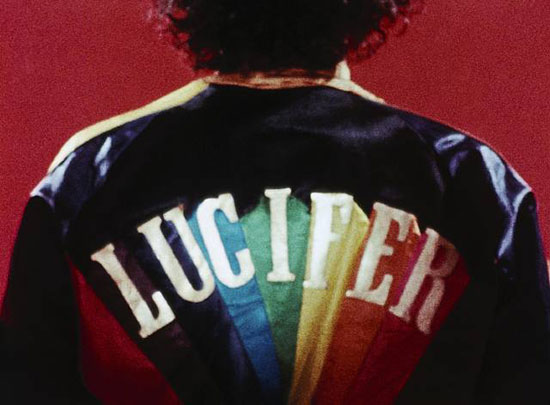 Film still from Kenneth Anger’s Lucifer Rising.Left to Right Militants
Film still from Kenneth Anger’s Lucifer Rising.Left to Right MilitantsMuch of the political instability of the 1990s concerns the disappearance of a familiar foe: Communism. During the Cold War, Americans of all persuasions found themselves ready to unite against a common enemy, putting aside even their longstanding xenophobia. The period’s two ultra-right organizations, the John Birch Society and the Minutemen, focused their ire almost exclusively on the Soviet Union. Yet, by the end of the 1980s, the Eastern European Communist bloc was falling apart. On September 11, 1990, President George Bush proclaimed the triumph of Western capitalism with the unfortunate choice of words, “new world order”:
We stand today at a unique and extraordinary moment….Out of these troubled times…a new world order can emerge; a new era—freer from the threat of terror, stronger in the pursuit of justice, and more secure in the quest for peace, an era in which nations of the world, East and West, North and South, can prosper and live in harmony.36
Bush’s Secretary of Defense, Caspar Weinberger, outlined its specific implications for US foreign policy:
[The New World Order] means that the US and other democratic nations agree to be governed by a rule of law whereby any country breaking that law is treated much as criminals are in each country. They are tried and, if found guilty, punished. The process will be carried out in the same manner that police and courts enforce local laws.37
Among conspiracy theorists, these statements resurrected fears of a secret, global cartel. In mainstream America the old xenophobia vigorously reasserted itself through a return to isolationism and bigotry. Ironically, from the standpoint of nuclear threat, this was the worst possible time to turn to isolationism. The Soviet nuclear arsenal fell into far less reliable hands, making the possibility of a nuclear holocaust now more likely than during the Cold War.
The success of 1960s and 70s progressive social movements left many on the right feeling that by the end of the millennium, American society will have fallen apart completely. The result has been a strident white, male backlash. A sense of going from persecutor to persecuted has created some strange identifications. Neo-Nazi propagandist Gary Lauck compared his exile from Germany with Lenin’s exile. Conspiracy theorists likened the 1995 bombing of the Murrah Federal Building in Oklahoma City to that of the Reichstag fire, seeing it as a plot to discredit the militia movement. Moreover, right-wing militants often adopt rhetoric and tactics from the very leftist activist groups they blame for social degeneracy. The name of David Duke’s National Association for the Advancement of White People, for example, mocks the venerable NAACP. Another group, calling itself the Men’s Rights Association, claimed that after feminism’s inroads into power, “Hard working men are reduced to the position of donkeys.”38 White Aryan Resistance (WAR) leader, Tom Metzger, explains his own political orientation vis-a-vis the legacy of the New Left:
We began to think a little broader and look into some of the left-wing positions, and we started evolving something that can’t be called right-wing. It can’t be called Marxist and it’s not really…The word populist has been ruined by the right wing, by the manipulations of [Willis Carto’s] Populist Party. We don’t accept that. We began to take on a lot of the positions of the left, and we started recruiting people from the left.39
Metzger is trying to reformulate National Socialism for the 90s; the Brown Shirts too were populists. Even so, as Catherine McNicol Stock explains, populist rural politics do not fit neatly into a conventional left/right opposition:
In its members’ contempt for the federal government, profound antiauthoritarianism, mockery of big business and finance, dedication to complete local control of the community, and desire to establish wilderness compounds, the new rural radicalism of the 1990s sounds surprisingly similar to the counterculture rhetoric of the far left in the 1960s. In fact, in northern California, the Pacific Northwest, and the rural Northwest it is not uncommon for gun-toting paramilitary leaders to live next door to latter-day hippies and marijuana growers. The…Murrah Federal Building [bombing] reminded some observers of the 1970 bombing of the University of Wisconsin’s Army-Math Research Center by a member of the local Students for Democratic Society.40
Some SDS-ers, like Lyndon LaRouche, have even switched camps, from left to right.41 New rightist groups, nonetheless, stridently oppose the social ethos of the left. Overall, their intent is the “resublimation” of culture: to turn back the advances of the previous thirty-odd years. This resublimation characteristically takes the form of a crackdown rather than increased compassion and understanding. If an “eros effect” drove, up to a point, the left movement, a politics of hate drives that of the right.42 A key figure in this broad ideological shift was not an ideologue at all, but a delusional schizophrenic: Charles Manson.
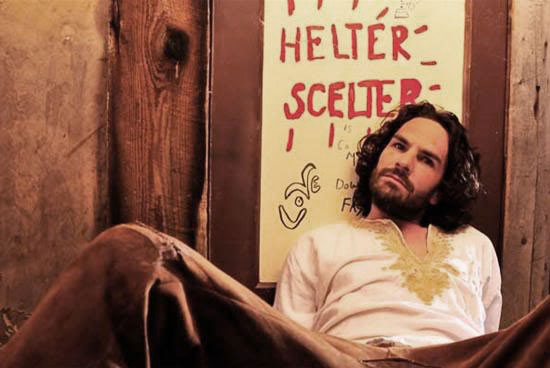 MSNBC docu-drama that follows Charles Manson at the Spahns Movie Ranch
MSNBC docu-drama that follows Charles Manson at the Spahns Movie Ranch
and the final days leading to the 1966 Tate/La Bianca murders.Helter SkelterResponding to an early morning call on August 9, 1969, Los Angeles police officers discovered grisly evidence of what would become the most publicized crime of its day: the slain bodies of Steve Parent, Voytek Frykowski, Abigail Folger, Jay Sebring and Sharon Tate Polanski at 10050 Cielo Drive in Bel Aire. Scrawled in blood on the front door was the word “PIG.” Assailants had shot Parent, Frykowski and Sebring with a .22 caliber pistol. They stabbed everyone but Parent with a bayonet. Tate, seven months pregnant, received multiple wounds in the abdomen. The next evening, other police investigators found Leno and Rosemarie LaBianca dead in their Los Feliz home, pillow cases tied over their heads with cords. Knife wounds covered their bodies. An ivory handled carving fork protruded from Leno LaBianca’s stomach; the word “WAR” was carved into his torso. “DEATH TO PIGS” was printed in blood on the north living room wall; “RISE” on the south wall and “HEALTER SKELTER” (sic) on the refrigerator in the kitchen. About ten days earlier, music teacher Gary Hinman had met a similar fate in his Malibu home. His living room wall bore the phrase “POLITICAL PIGGY,” also in blood.43
Prosecutor Vincent Bugliosi believed that these three crimes were all the work of Charles Manson and a group he had formed around himself called “The Family.” Because Bugliosi had little direct evidence implicating Manson—whom he considered the ringleader, he had to show that the group, at Manson’s bidding, had conspired to commit a series of premeditated murders. In other words, he had to unravel and articulate Manson’s idiosyncratic vision of Armageddon. Drawing on the conservative breakdowns of the 1960s, Manson prophesied that black people all over the world would soon rise up and slay their white oppressors. Meanwhile The Family would retreat into caves around Death Valley. After the purge, they would return to reclaim their rightful position of power and regenerate the white race. Manson, of course, would rule the world. He had seen the coming apocalypse prophesied in songs from the Beatles White Album: “Helter Skelter,” “Blackbird,” “Piggies,” “Sexy Sadie,” “Revolution” and “Revolution No. 9.”44
Charles Manson grew up a perpetual outsider—moving from foster homes to reform schools to prisons—with only brief interludes between. It was during his last such period that he ran completely amok, leaving a remarkably deep impression on the disaffected elements of American society. As an aspiring rock musician, he once brought The Family to live with Beachboy Dennis Wilson. Wilson’s friend Gregg Jakobson unsuccessfully tried to interest producer Terry Melcher (then married to Candice Bergen) in Manson’s music. Manson took Melcher’s indifference as a personal affront. Roman Polanski and Sharon Tate were unlucky enough to have taken over Melcher’s lease at 10050 Cielo Drive; revenge was clearly one motive for the killings there. Although Wilson had downplayed his opinion of Manson’s talent to Melcher, the Beachboys later recorded his song “Cease to Exist” as “Never Let Your Love Die.”45
Other Family members had tenuous links to parts of the counterculture as well. Before hooking up with Manson, Bobby Beausoleil knew film maker Kenneth Anger and played Lucifer in Anger’s film Lucifer Rising.46 At the Hinman murder scene Beausoleil drew a bloody paw print on the wall in an attempt to implicate the Black Panthers—and by that precipitate “helter skelter,” the black uprising. Manson had also bragged about “killing a Black Panther.” It turned out, however, that the man in question, drug dealer Bernard Crowe, had never been a Panther—nor did he die after Manson shot him. Although Manson was a white supremacist, he regarded Black Panthers and Black Muslims as “the true black race,” i.e., as groups destined overturn the corrupt white establishment. The erosion of traditional patriarchal underpinnings was just one sign of that corruption; Manson believed that women should eventually be re-subordinated to men.47
When The Family moved to the abandoned Spahn Movie Ranch, its cultist activities and beliefs intensified. The ranch once served as a set for Westerns starring, among others, William S. Hart, Tom Mix, Johnny Mack Brown, and Wallace Beery before it fell into disuse. There, Manson combined techniques derived from Scientology with LSD and group sex to indoctrinate new members into his cult. This combination effectively broke down initiates’ sense of self and severed earlier familial and social identifications. Psychically leveled, they bonded absolutely to their charismatic leader. Oddly enough, the resulting social structure bore an uncanny resemblance to the “primal horde” postulated by Sigmund Freud in Totem and Taboo; The Family’s very name parodied the nuclear family.
Throughout Manson’s murder trial, Family women kept a vigil outside the Hall of Justice in downtown Los Angeles. Imitating their leader, they carved first crosses, then swastikas into their foreheads. After the guilty verdict, all those convicted shaved their heads. Later, various Family members either stated outright or implied that the group had been involved in an additional 20-30 murders, including that of Manson’s own “hippie attorney,” Ronald Hughes. Officials never solved most of the other cases. Of those convicted, all involved in the Tate-LaBianca slayings remain behind bars.
Inside prison, the Aryan Brotherhood purportedly contacted Manson during the 1970s.48 On the outside, various subcults, of all political persuasions, celebrated—and continue to celebrate—the Manson myth. Yet, after twenty-eight years, all but two Family members have renounced their former leader. Charles Watson (who had once called his victims “just blobs”) and Susan Atkins became born-again Christians. Only Lynette “Squeaky” Fromme and Sandra Good remain unreformed—and, of course, Manson himself.
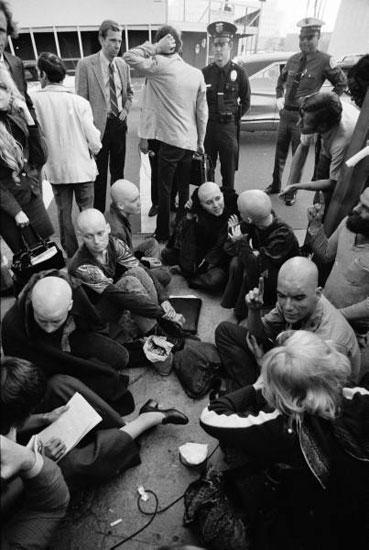 The Family outside the courthouse during the trial of cult leader Charles Manson,
The Family outside the courthouse during the trial of cult leader Charles Manson,
having shaved their heads in protest.Manson and the Radical RightUndoubtedly, part of The Family’s appeal during the tumultuous 1970s had been its promise to purge the established order of its hypocrisy, by—ironically—replacing repressive tolerance with outright repression. Throwing the status quo into sharp relief, Manson did manage to expose something of its arbitrariness. Family members cynically understood murder as a deliverance from the world’s evils—that “when you stab someone, it feels good when the knife goes in.” This absolutism, however deranged, came across as a potent antidote to the hippie movement’s growing complacency, particularly “flower power’s” shallowness.
More psychopathic than ideological, Manson’s deeds and posturing nonetheless carried a political charge. They became a symbolic screen onto which other left extremists could project their own fantasies. Before she went underground, Bernadine Dohrn told an SDS convention, “Offing those rich pigs with their own forks and knives and then eating a meal in the same room, far out! The Weathermen dig Charles Manson.” Jerry Rubin echoed her cavalier adulation, “I fell in love with Charlie Manson the first time I saw his cherub face and sparkling eyes on TV.” Tuesday’s Child, an underground newspaper that called itself “the Voice of the Yippies,” made Manson its Man of the Year.49 This misguided adulation of Manson registers the extent to which cynicism had overtaken the movement. Manson’s popularity as a cult figure thus marks the beginning of a shift from left to right in the underground paradigm.
In at least three respects The Family anticipates the survivalist movement and the racist religious sects of the 1990s. First, its apocalyptic racism prefigures the white backlash to affirmative action and civil rights. As racist and sexist social structures began to break up, many white men saw themselves as a new, specially persecuted minority. They blamed their declining standard of living on the social and economic ascendence of women and minority groups. Echoing Manson’s delusional cosmology, William Pierce’s influential novel The Turner Diaries offers a futuristic vision of an African-American takeover of the white population and an ensuing race war. Although it is fiction, this book later served as a template for all-too-real terrorist acts.
Second, The Family exemplifies how a terrorist cell can be modeled on the “intentional community.” This term denotes a community brought together for a deliberate purpose: overriding the refractory social and economic forces that typically bring diverse groups of people together. In the United States, early intentional communities include the Amish and the utopian communes of the nineteenth century. More pertinent, though, are the hippie communes out of which the Family emerged. These favored the group over the individual; their goal was to abolish egoism. With few individualist ambitions, these communal groups might then fall prey more easily to gurus and con artists. A fundamental motivation for the hippie commune, moreover, was dropping out, which meant breaking with mainstream society and constructing an alternative culture. Although Manson was no hippie (he could be construed as an anti-hippie), he took this principle to an extreme. Self-styled prophets Jim Jones, David Koresh and those of the more recent Heaven’s Gate cult—though not pointedly right-wing—have followed in his wake. The Family, however, was homicidal, not suicidal. More recent racist Christian groups, such as Aryan Nations and The Covenant, the Sword and the Arm of the Lord (CSA), update the hippie tactic of dropping out through the rubric of survivalism. Like The Family, they are militant—more so in ultimate objectives. They differ tactically in that Manson only wanted The Family to instigate a race war, not actually wage one. In The Turner Diaries, William Pierce outlined a similar role for the Order:
Finally, the far right believes in the subjugation of women. Although he relied almost exclusively on women to carry out his plans, Manson believes this too. Ironically, his own lifestyle obliterated even the most rudimentary semblance of home and family which, for the right, define femininity. Where Manson differs most significantly from the recent hate groups is that he was not overly concerned with anti-Semitism, populism or Constitutionality.50
Christian IdentityIn present-day America, the Christian Identity Movement codifies a hatred and paranoia analogous to Manson’s. The movement’s precursor was, oddly enough, a philo-Semitic theology: British-Israelism. John Wilson, the son of a radical Irish weaver, set forth this belief in an 1840 book entitled Lectures on Our Israelitish Origin. Edward Hine definitively reshaped Wilson’s doctrine in his 1871 book Identification of the British Nation with Lost Israel.51 It construed Anglo-Saxons to be the descendants of the lost tribes of Israel and also belonging to God’s chosen people. As a millenarian belief, British-Israelism survived through a combination of specificity and vagueness, leaving its predictions open to constant revision. It was highly decentralized and subject to variation. As the Zionist movement came to the fore in Britain, aspects of the belief took on a low-key, anti-Semitic inflection. Because Anglo-Israelites believed that both the House of Israel (the Anglo-Saxons) and the House of Judah (the Jews) must return to the Promised Land before the Second Coming, Zionist exclusivity presented an obstacle to their redemption.52
British-Israelism first came to the United States around the late 1870s. Joseph Wild of the Union Congregational Church of Brooklyn was one of its first American preachers. Under the doctrine then, America—or Manasseh—would play a subordinate role to Britain in salvation. In the US, however, what had been philo-Semitism mutated into outright anti-Semitism via a focus on racial origins. A combination of Victorian-era pseudo-science and specious scholarship continuously defined and redefined these, progressively denigrating Jews. In the 1930s Howard B. Rand emerged as a key popularizer of British-Israelism. He founded the influential Anglo-Saxon Federation of America. Rand’s group embraced James Larratt Battersby’s The Holy Book of Adolf Hitler, which portrays der Führer as a religious saint. Among other things, it advocates polygamy to better propagate the Aryan race.53 Rand made Detroit the Federation headquarters and it was there where he met a fellow believer: William J. Cameron, the former editor of Henry Ford’s Dearborn Independent. Having written and edited much of The International Jew, Cameron sometimes lectured on “Biblical economics” to church audiences. As a professional publicist he aided in spreading the belief as a vehement anti-Semitism.54
More than any other, Wesley Swift was the figure around whom a fully-formed Christian Identity belief—with no remaining ties to Britain—coalesced. A friend of Gerald K. Smith, Swift successfully popularized Identity in right-wing circles through a combination of extremist religious, racial and political platforms. Swift’s theology embraced a Manichaen world view which merged religion and politics. It reinterpreted the book of Genesis, postulating a “two seed theory,” according to which both Adam and the Devil, as the serpent, impregnated Eve. It construed the name “Adam” to mean “showing blood in the face.” This ability to show shame or embarrassment is what supposedly distinguishes the Aryan race from others.55 Anglo-Saxons are therefore the “Adamic race,” while Jews are “spawn of the Devil” and thus, absolutely demonized. Yet, this portrayal creates an obvious contradiction. On one hand, Identity warns of an overwhelming Jewish threat; on the other, it claims that Aryan supremacy is inevitable. Other races, or “mud people,” are “pre-Adamic,” i.e., created by God before he perfected the first full-fledged human beings.56 Because Christian Identity churches view the United States as “God’s Country”—or more specifically as New Israel, Jews no longer play any part in the End Days. The return of the True Israelites to the Promised Land presages Armageddon, the ultimate battle between good and evil prophesied in the Book of Revelations. Identity followers believe they had already reached this stage during the Revolutionary War. Again, it is Michael Barkun who clarifies the radicalization and separatism that arise from this twisted logic:
Since the essence of conspiracy theories is their claim to parsimony—explaining all evil through single causes—the incorporation of satanic paternity into already existing theories of a world Jewish conspiracy gave to the theory ultimate parsimony: everything that was or is undesirable in the world has come from a single source. If that source is destroyed, the world will be perfected and the millennium will begin. Further, as with all conspiracy theories, this one defies falsification. A plot of such cunning is presumed to be able to mislead those who would try to detect it, so that any evidence that appears to contradict the theory must necessarily have been fabricated by the conspirators themselves. Paradoxically, as far a conspiracy theorists are concerned, the more innocent the putative conspirators appear to be, the more clearly they are implicated, for their apparent innocence is taken to be proof of their complicity. Thus the theory becomes a closed system of self-referential ideas, from which all contradictory information has been excluded.57
Moreover, Richard Abanes warns against the dangers Manichaenism presents in the Christian Identity movement:
A Manichaen world view…becomes dangerous if combined with militancy. For militant Manichaens, persons outside the realm of absolute good are seen as utterly evil opponents who must be destroyed. When militancy and Manichaenism are blended with apocalyptic ideas about the world’s end being near, the potential for violence grows very great.58
Swift founded his church in Lancaster, California in 1946 and later changed its name from the Anglo-Saxon Christian Congregation to Church of Jesus Christ Christian (as opposed to Jesus Christ, King of the Jews). He had also been involved in an attempt to revive the California Ku Klux Klan in the 1920s and later headed the California Anti-Communist League. During the 1960s he was reputed to have formed links with paramilitary groups: the California Rangers and the Christian Defense League.59
William Potter Gale, a retired lieutenant colonel who had served under General Douglas MacaArthur in the Phillippines, joined Identity in the 1950s and became active in the Christian Defense League as well. Heading the League was yet another Identity preacher: Richard Girnt Butler.60 Gale became one of the few to attempt to systematically articulate Identity doctrine in his 1963 pamphlet “The Faith of Our Fathers.”61 More recent figures with Identity links include Tom Metzger, David Duke, Pete Peters and Robert Miles.
Barkun assesses the status of the movement:
Identity is, even by the standards of American sectarianism, a tiny movement. Accurate estimates of its size are impossible to obtain because of its decentralized character. It has no denominational structure, merely shifting and overlapping groups with family resemblances to one another. However, even the guesses have placed its maximum size at no more than one hundred thousand, and it may be less than half that. Further, there is no evidence Identity can attract large numbers of new members, although it has proselytized among small populations of the alienated (e.g., skinheads and white prison inmates). Consequently, it cannot look forward to a foreseeable future as a mass movement.62
Even so, it exerts a disproportionately large ideological influence. James Ridgeway notes:
Identity theology provides both a religious base for racism and anti-Semitism, and an ideological rationale for violence against minorities and their white allies.
Identity followers have little use for fundamentalist Christians on the New Right (who, in turn, view Identity theory as heresy). The fundamentalist belief in “rapture”—the instant during the last days of the world when God will suddenly appear to protect his true believers and call them bodily into his presence—seems absurd to Identity worshipers. An Identity Christian isn’t about to wait for God to save him; he puts more faith in….direct political action.63
The movement brought together many otherwise antagonistic factions. As its name implies, the psychological basis of Christian Identity concerns identity formation and reinforcement. This process typically requires the construct of “otherness” to fortify a sense of self. The belief has come into prominence just as so-called processes of globalization have most dramatically challenged accustomed identities and social roles. In contrast to these uncertainties, Christian Identity guarantees a pan-historical selfhood. Real-life identities, however, are historically variable; one period’s distinguishing features may, at another, become insignificant. An aggressive ambivalence also marks the belief. Although its hostility arises from the paranoid suspicion that the Jews may really be God’s chosen, a latent Anglo-Israelite identification with Jews persists. More devout Identity Christians, for example, assiduously copy the dietary and sexual codes of orthodox Hasidim.
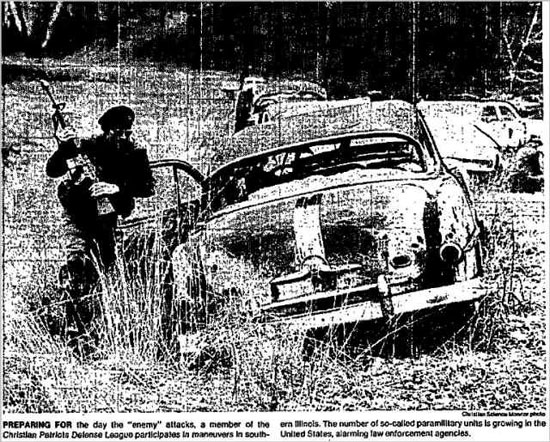 Christian Patriots Defense League paramilitary training at Illinois compound, May 1981.Aryan Nations
Christian Patriots Defense League paramilitary training at Illinois compound, May 1981.Aryan NationsAryan Nations began when Richard Butler took over the California Christian Identity Church upon the death of its founder, Wesley Swift. Butler’s lackluster preaching, however, made him unpopular with Swift’s old congregation. As a result, Butler moved the church to Hayden Lake, Idaho. Under the slogan “one God, one Nation, one Race,” he augmented the church with a political wing: Aryan Nations. Butler reasoned that other races had their national homelands, so why not Aryans? He proposed a ten-percent solution, where one-tenth of the United States would be set aside for the exclusive use of Aryan Christians. The Aryan Nations were to consist of the Pacific Northwest states of Washington, Oregon, Idaho, Montana and Wyoming. Butler planned to develop a congregation of 144,000 as foretold in the Book of Revelations. The movement would continue to expand until it could take control of this area through sheer numbers.64
To this end, Butler inaugurated a program of annual Aryan World Congresses, to attract and consolidate white racist groups internationally. He initiated the Aryan Brotherhood, a program of prison recruitment, but this was more trouble than it was worth. He soon abandoned it. Aryan Nations congregants began harassing Jewish and African-American locals. One day Sidney Rosen came to work to discover swastikas and the slur “Jewish swine” spray painted over his Hayden Lake steakhouse. Rosen put the property up for sale and closed his business within a year. Posters soon appeared in nearby Couer d’Alene and Spokane,Washington showing a target with a black man’s silhouette, the words “Official Running Nigger Target” printed underneath.
One early morning in June 1981, Butler and his wife awoke to a loud explosion. Outside, Butler saw smoke pouring out of Aryan Hall. Someone had targeted him. Butler suspected the Jewish Defense League, but the bombing remains unsolved. Shortly after that he built a 29-foot guard tower at Aryan Hall and a sentry post with a sign “Whites Only” at the property’s entry gate. Rocky Mountain News reporters Kevin Flynn and Gary Gerhardt described the new atmosphere inside the compound as “an offbeat blend of Walden Pond and Berchtesgade, there was insular affection intermingled with fortress mentality among the people there.”65
In September of 1982 a citizens’ group called the Kootenai County Task Force on Human Relations formed to combat racist harassment. It successfully sponsored a bill making it a state crime to harass or intimidate anyone because of race. The penalty for such a crime was set at five years in prison with a $5,000 fine.66 Even so, through the annual Aryan World Congresses, Aryan Nations has continued to serve as the focal point for a growing extremist movement.
For the most part, the kind of right-wing religious militancy espoused by the Christian Identity movement or Aryan Nations belongs to another era. Instead, the sentiments that once drove radical separatism now instead seek to transform the mainstream. Witness Republican presidential candidate Rick Santorum’s recent assessment of John F. Kennedy’s 1960 speech to Baptist ministers in Houston, a speech that reaffirmed Constitutional separation of church and state. Santorum said it made him want to “throw up.” What is perhaps most alarming in this is that it signals a perceived feasibility of merging church and state. Separatism is no longer necessary. Part III of this essay, “Posse Comitatus/ Grassroots Rebellion/ Secret Societies” will examine the open conflicts that took place between the radical right and the U.S. government in the form of seiges and stand-offs during the 1990s.










